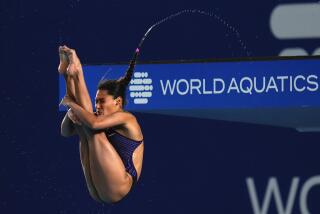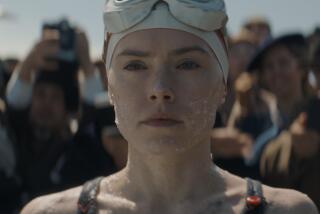Navy’s First Female Diver Took the Plunge
- Share via
Donna Tobias’ recent induction into the Women Divers Hall of Fame released a torrent of memories of her experiences in the Navy--few more vivid than her time in the Mark V.
The Mark V, no longer used by the Navy, was a diving suit made of rubberized canvas, with a spun copper helmet and breastplate and one-size-fits-all lead boots. It was a behemoth of a suit. On land, it weighed 200 pounds to Tobias’ 135, but in the water it allowed her to withstand the pressure at depths of more than 100 feet.
“On a daily basis, it was the single biggest obstacle,” said Tobias, a petite woman with a quiet voice and calm demeanor. “That suit was huge on me. I’m 5-foot-5 on a tall day, and my feet are small. Those boots were tough. They weighed 17 pounds each, and my foot only filled half the shoe. I even had dreams about those shoes.”
It was an arduous climb up a ladder out of the water, trying to place her lead-weight boots on each rung: “My foot would just hang down, trying to lift those boots. You had to get your momentum going. Once you started, you could not stop.”
Her nemesis on land became her best friend in the sea. “It was cumbersome on land, but in the water, you could move around; it was less of a problem. In the water, I felt safe in it. I can smell being in this suit--smell the air, the metal, taste it, you know? I got to be fond of it, in the water.”
That suit would challenge any diver, man or woman. But in the Navy, no woman had ever won the right to wear it--not until Tobias in 1975 became the Navy’s first female deep-sea diver.
From her first scuba dive, Tobias wanted to spend her life on the water. That passion would ultimately lead her to challenge one of the most elite bastions in the military. “It’s only been in the last few years that I’ve really begun to talk about it,” said Tobias, who lives in Waterford, Conn., and teaches at New London High School. “I didn’t want people making fanfare over me, because we were all going through it. It was an accomplishment for women. It was a door opening.”
Tobias, 48, grew up in Southern California and joined the Navy because of her love of the water. “Even when I was talking to my recruiter, I asked about going to diving school. He said no way, women couldn’t get in there,” Tobias recalls. After basic training, “I pressed to find out what a person had to do to become a diver, and they came up with a long list of things. . . . I just went through each thing one by one.” She ignored naysayers who believed women didn’t belong in diving school. She applied to the Navy 2nd Class Diving School and heard nothing until she received notice that she had been accepted, two days before the program started in January 1975. Tobias was 21.
During the grueling 10-week course at Little Creek Naval Amphibious Base in Norfolk, Va., where half of the class typically drops out, Tobias learned all phases of deep-sea diving: search and rescue, “hard hat” diving and salvage, as well as studying physics and medicine.
*
Diving school was a mental as well as a physical test, compounded by the men’s resistance to a woman in their midst. “Some couldn’t get over their own wonderment over how I could wear the metal breastplate, if it was an issue for my breasts,” she said. “There were some that were so threatened--what would it say about them if a girl could do this?”
Looking back, Tobias said, “I have some perspective on it now, and I feel it was a learning experience for all of us. The highest compliment is for someone to say, ‘I’ll go in the water with you.’ And some of those who resisted me the most at first, we became the closest in trust. I watched myself grow, and what was powerful over time was watching people become their best self.”
She graduated with a class of 14 in March 1975. “When you go through something like that together, you get pretty close to people,” she said. After graduation, Tobias was assigned to the Naval Submarine Base in Groton, Conn., where she taught sailors how to escape from a submarine in a giant water tower known as the escape training tank. The 125-foot-high metal cylinder was filled with water more than 100 feet deep.
Steven Lechner, a retired Navy master diver, worked with Tobias at Groton. He met her in 1977. “She had to prove herself, to be twice as good at everything, and she was. She’s remarkable; she has a tremendous amount of courage.”
Lechner said Tobias was the first woman to teach in the escape tank. “After she proved herself, everyone looked up to her and admired her, because they knew she was the only woman in the whole Navy at the time doing that.”
As a Navy diver, Tobias worked in ports on naval vessels, took part in search and salvage operations in the Long Island Sound and the Atlantic Ocean and participated in the sinking of a World War II ship to construct an artificial reef in Chesapeake Bay.
At Groton, she worked in the hyperbaric chamber, which treats divers suffering embolisms, as well as people with carbon monoxide poisoning and gangrene. “We saved people’s lives, which was immensely satisfying,” Tobias said.


